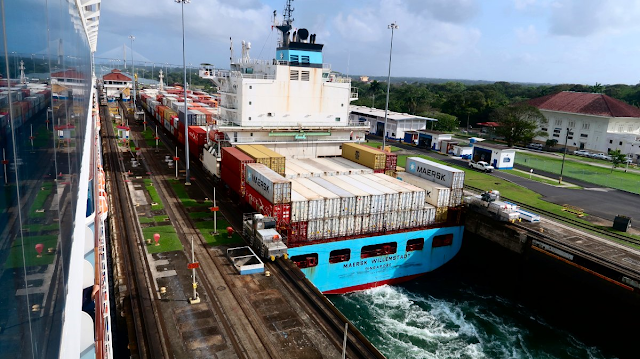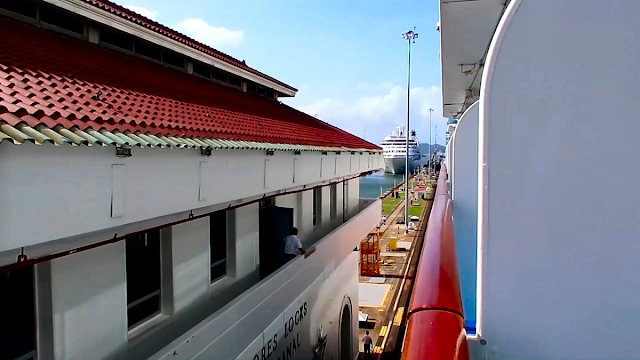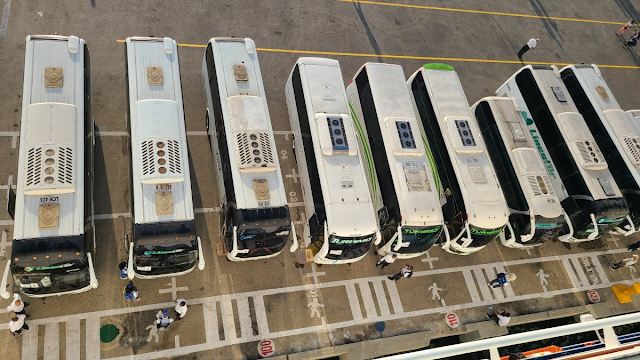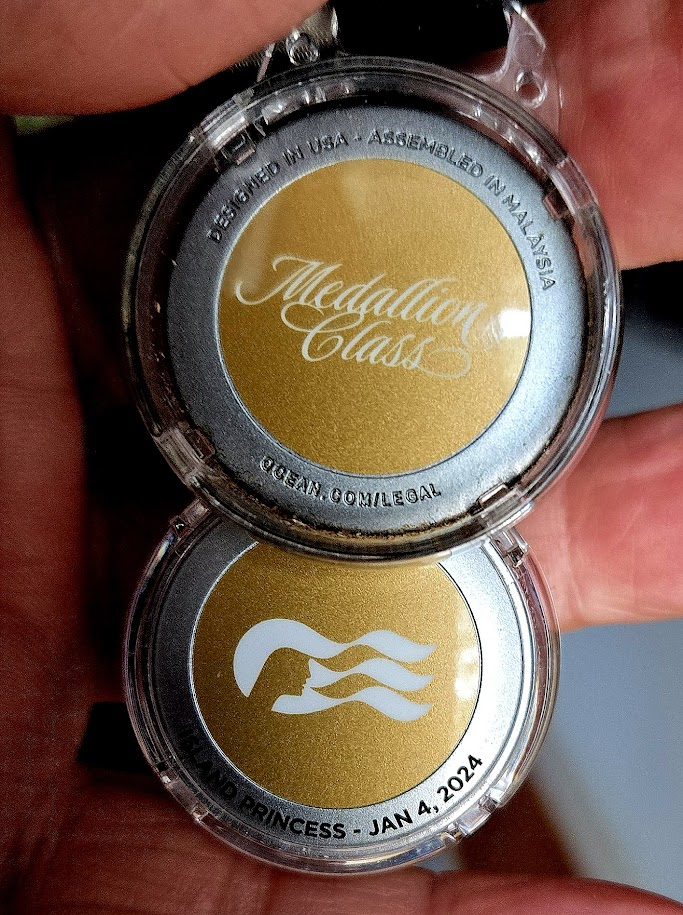I rose even earlier than normal, the excitement of photographing the approach to the world-famous Panama Canal was just too much to sleep through. As I waited for an elevator to take me to the top deck, I was not alone. Many fellow passengers, most of them with cameras other than just their cell phones, had the same feelings I did. They were anxiously fiddling with their equipment or their clothes as we waited to arrive at the top. As we walked around the pool area headed for the staircases to the upper deck, we encounter the strangest decision I have ever seen by a cruise line in my seven previous cruises: the stairs to the observation area on the top deck, the sports deck, is chained off!
Here we are, on a not inexpensive, once in a lifetime cruise, taken specifically to see the Panama Canal, and the one viewing area that has been open the previous two days, this morning, with the city lights of Colon, Panama, shining brightly in the background, is inexplicably closed to passengers! The iconic Atlantic Bridge, the newest bridge over the canal, is tantalizingly illuminated in the distance, but we can see only portions of the view ahead from the lower decks. The growing, milling crowd begins to question the frustrating decision, but no one wants to test the omnipotent power of the cruise officers and no one crosses the chains. The canal draws closer to the entrance to the canal in the fading darkness, but the chains remain in place, then someone happens to notice someone leaning over the rail above us. “How did you get up there?” someone yells. The startled explorer yells back, “I don’t recall!” Through the Bar and Grill, because the doors exiting the restaurant to the sports deck are wide open! The sports deck is soon filled with passengers snapping unobstructed photos of the oddly purple sunrise with the gateway to the canal in front of them.
It is a marvelous time, waiting in the dim morning light to see something you have heard and read about your whole life, and yet I have a feeling of dissatisfaction or, more like a realization, that this is no big deal. There are many freighters and small ships of all sizes anchored at the mouth of the canal, all waiting for their clearances to enter. Some appear to have been waiting quite a while. A fleet of big, oval shaped ocean-going tugs race around the ship like over-sized water bugs as we slowly approach the Atlantic Bridge from Limón Bay, but none of them makes contact with our ship.
By the time we enter into the river-like waterway most of us have returned to our balcony cabins to watch the transit from well above the mechanical mules, the railroad like tractors that guide us through the locks. One look at the towering, iconic Gatun locks in front of us brings back the awe of the moment. A ship entering the locks from the other side is so high above us it doesn’t look like a ship at all.
We are moving so slowly it is hard to discern any movement. Only by looking down at the seawall can we see the perceptible, unbelievable closing between us and the walls of lock. We can’t be doing more than one or two miles an hour. I can easily walk faster than the ship is traveling as we enter the first lock.
One reason we selected the Island Princess is she transverses the old, traditional locks at Gatun, Pedro Miguel, and Miraflores, the latter two located over on the other side of the isthmus, just before the canal empties into the Pacific Ocean.
The new, wider and longer locks at Gatun are the Aqua Clara locks, out of sight to the left, farther east, as you enter from the Caribbean. They were only recently built to relieve the traffic through the 110 year old, 110 foot wide original Gatun locks. They both enter Gatun Lake and from there to the locks fifty miles away on the other side, and in a moment of unrestrained alliteration, ships share the same waterway. That is as close as I get to poetry.
By the time we get through the Gatun locks, we are tired of standing up and leaning on the railing. Time to take a break and stretch our legs as we enter Lake Gatun, the fresh water lake that supplies all the water to make this huge, ingenious system work. We were told that every ship's passage through the canal takes around 51 million gallons of water. Since water only flows out from the lake to the Atlantic and Pacific oceans on either side, no water flows between the two oceans. No water flows in from the sea. The lake is replenished by rivers and rainfall, and during droughts the canal authority restricts the number of ships that can use the canal as the water level in the lake begins to lower to seriously low levels. Salt water can't be pumped back into the lake as that would contaminate the country's drinking water supply.
In our struggle to take unobstructed photos and videos, we discover there are very few viewing areas on the Island Princess available. If what you want to see is on the same side as your cabin, you have no problem, but to see ahead or behind the ship leaves much to be desired. Up on top, the distorted, blue glass windscreen panels that surround all the public areas makes most photography futile. If you want to see something on the other side of the ship, there is little area that is suitable other than a small narrow section near the Bar and Grill. The stern isn’t much better so we return to our balcony cabin where we can at least have one unobstructed view of the transit.
Those problems fade away as we silently cruise past the hardwood jungle forest that comes right to the water's edge. We are captivated by the thick, lush foliage that reminds us of home. Not everyone sees it the way we do, of course, but we are still used to the last strands of mahogany hardwoods in the Florida keys and feel a strange tinge of longing for days gone by. There are few houses or buildings on the water, most tucked far away from the canal itself. Soon it is all forest as the lake begins to open up with small islands on the far shore. An occasional long, slender power boat passes us, but the canal is quiet. We have one other ship quite a ways behind us, but we don’t pass any other ships headed the other direction.
The next several hours are spent relaxing and watching the lake slowly turn into a river. We casually watch as hills in the distance grow larger and come closer to the water's edge. The visible scars on the landscape become more and more obvious as we head further south. Oddly, even though we are headed toward the Pacific Ocean, we are headed southeast approaching the ridge of mountains that runs the length of Panama. The exit from the canal into the Pacific at Panama City is further east than Colon, where we entered from the Caribbean.
The thought that over 22,000 men died digging this canal is somberly personified by the terraced, rocky pass through the stone mountain just this side of the second bridge. For three years, all the dynamite manufactured in the United States, over 60 million pounds, was used to blast though the mountains to make this canal, and we blithely cruise through it looking at our cell phones.
We pass under the second bridge, the Centennial Bridge, opened in only 2004, and the locks at Pedro Miguel come into view. Again, I stand on our balcony for the entire passage even though the temperature outside in the blazing sunshine is now in the high 90's.
We approach the Pedro Miguel locks slightly off center as wind slowly pushes us to the east in the canal. We all but stop as we lie off from the entrance to the last lock, obviously out of position, and watch in awe as two men climb down a ladder on the side of the lock and climb into a row boat. One man rows slowly toward our bow while the other handles a rope being strung out behind them. They disappear for a few moments beneath our overhang and reappear shortly, rowing almost nonchalantly back to the lock. A team on the lock attaches the line to a mule and within a few minutes of winding and pulling, we slowly, correctly, enter the lock. I'm absolutely astonished that in this day and age of marvelous, ingenious gadgets and mechanical tools, that this simple, inexpensive method that has been used now for over 110 years, still works just fine.
 |
| Schrödinger's Cats at Pedro Miguel |
The last locks at Miraflores are not far from the exit of Pedro Miguel, but I'm startled when I watch the LPG tanker with its huge oversize on-deck storage tanks that has been behind us since we entered Lake Gatun, sail past above us to our right, still at the level before the Pedro Miguel lock. She is far wider than the Island Princess and is taking the route through the new locks. The new Miraflores West lock take the place of both the original Miraflores and the Pedro Miguel locks, but being 70 feet wider and 18 feet deeper, it requires far more water for a single-ship transit than the old locks. The old locks will be in use for many, many years to come.
We pass a staff member who steps out of his office onto the office balcony just as we glide by. Greetings are shouted back and forth from different parts of the boat, some in Spanish, all greeted with laughter and waves.
We soon pass under the third and last Bridge, the old original Bridge of the Americas, and can see the skyscrapers of Panama City, home to two million people off to the east.
The new fourth bridge over the canal is under way not far from the original, but the new massive integrated road and rail undertaking is still years from completion. From what we got to see on this trip, it should be a piece of cake.
It has taken just over eight hours to go from the Atlantic to the Pacific ocean. We stood for much of the trip, but we had lunch, walked several decks searching for good vantage points, at least ones not so crowded we could get to, and were quite sunburned by the time we went to dinner. A marvelous cruise, maybe we'll do it again some time. Maybe next time we'll start in L.A.
Next: Puntarenas, Costa Rica - https://piddlepaddler.blogspot.com/2024/11/the-panama-canal-cruise-part-4.html
A 27 minute HD video of this blog is at: https://youtu.be/-ouMXldv7zY
Previous - Cartagena, Colombia - https://piddlepaddler.blogspot.com/2024/11/the-panama-canal-cruise-part-2-cartegena.html




















































